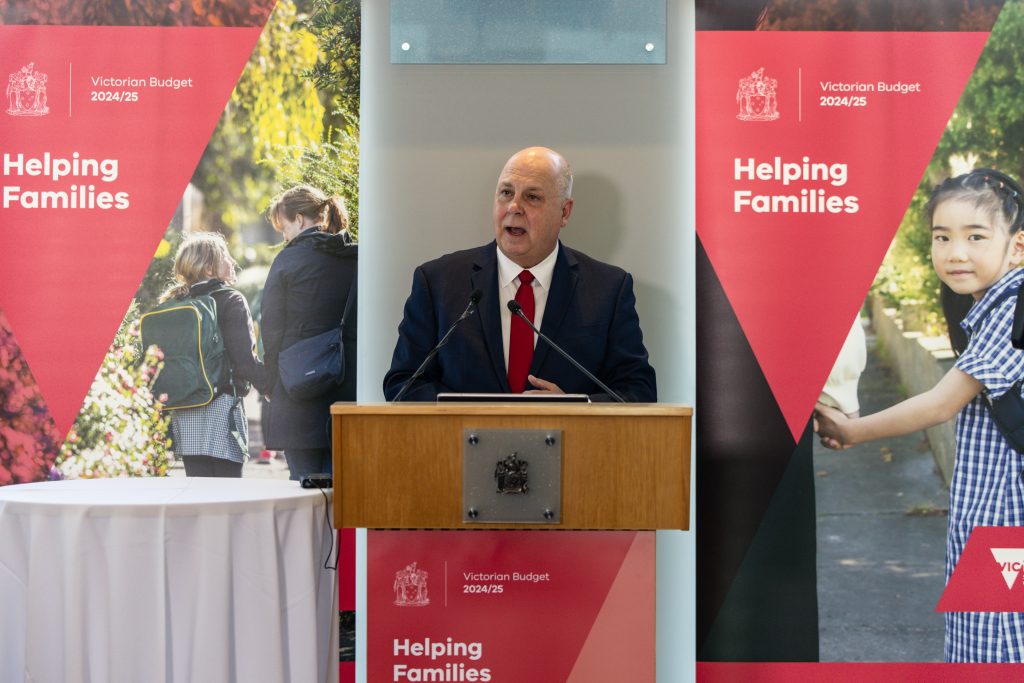 Written by Steve Michelson & Gordon Meredith
Written by Steve Michelson & Gordon Meredith
With the dust settling on the piles of Budget papers, and the headlines of winners and losers fading into last night’s news, now is an appropriate time for a nuanced look at Tim Pallas’ “disciplined” 10th Victorian Budget as Treasurer.
It was a no-thrills budget that looked to limit debt accumulation, stabilise the progression of the major infrastructure projects already underway and signpost key issues that the Allan Government may want to prioritise in the lead up to the next election.
The Government showed a moderate willingness to invest in initiatives, but only where they are supported by clear outcomes, and only when blockages to their rollout are addressed.

Victorian Treasurer Tim Pallas speaks during the Victorian State Budget 2024/25 Media lock-up in Melbourne, Tuesday, May 7, 2024. (AAP Image/Diego Fedele) NO ARCHIVING
Below is a summary of the Government’s key objectives and Budget commitments across major policy areas:
Reducing Government’s Footprint
 As part of their commitment to “fiscal responsibility” the Government reviewed its internal budgeting processes now that day-to-day pandemic operations have concluded.
As part of their commitment to “fiscal responsibility” the Government reviewed its internal budgeting processes now that day-to-day pandemic operations have concluded.
The Government has committed to reducing its “footprint” via a reduction in operational spend, as well as the physical office spaces it occupies.
Part of the reasoning behind this was an acknowledgment of the “changed nature of work” where working “a couple of days from home is now the norm.”
It will be worth tracking how the Government’s continued adoption of hybrid working arrangements influences the behaviour of other sectors who are experiencing a slower than expected return to offices.
Increasing Workforce Capacity
 Workforce capacity was one of the key roadblocks highlighted in the Treasurer’s budget address, partially as a reason for delaying the completion of the Government’s 2022 election promises but also to highlight training and workforce growth as one of its focus areas for the immediate future.
Workforce capacity was one of the key roadblocks highlighted in the Treasurer’s budget address, partially as a reason for delaying the completion of the Government’s 2022 election promises but also to highlight training and workforce growth as one of its focus areas for the immediate future.
The housing crisis, an overrun healthcare system and “The Big Build” are key policy pillars for this Government, and under pinning all three is an ability to maintain a workforce large enough and skilled enough to execute the projects.
Commitments to initiatives such as Free TAFE and Skills First Skill Set show the Government’s appetite and need for more training programs.
Strengthening Victoria’s Healthcare System
An interesting element of this budget was the difference between Government’s attitudes towards committing substantial funding to (certain) hospitals in an attempt to address “front line” health issues, in comparison to the modest funding allocations for General Practice and Allied Health services. Access to regular bulk-billed GP appointments, and the services that GPs refer to, was a pain-point for the industry prior to the budget, but limited funding was allocated to address these issues.
Access to regular bulk-billed GP appointments, and the services that GPs refer to, was a pain-point for the industry prior to the budget, but limited funding was allocated to address these issues.
Furthermore, the so-called “Patient Tax”, that would see GPs pay Payroll Tax on direct payments for services provided was not addressed, leaving GP advocacy groups concerned about increased costs being passed onto patients in the immediate future. Rumour has it the government’s position may be under review following the Opposition Leader’s commitment to introduce legislation to repeal the GP tax.
A Careful Transition to Renewable Energy
 A “plan for the energy transition” was another key focus of this budget, and the Government’s commitment to the Electricity Commission (SEC) Centre of Training Excellence highlighted an interest in investing in initiatives that to help train a workforce that will support Victoria’s transition to cleaner, cheaper energy.
A “plan for the energy transition” was another key focus of this budget, and the Government’s commitment to the Electricity Commission (SEC) Centre of Training Excellence highlighted an interest in investing in initiatives that to help train a workforce that will support Victoria’s transition to cleaner, cheaper energy.
Electrification is clearly this Government’s transition preference, with most of the budget announcements pertaining to wind, solar or battery projects, alongside a commitment to streamline the assessment process of future renewable projects.
The continuation of the popular ‘Switch to Solar’ rebates confirmed, however, that the Government is still cautious of inflicting too much of the financial load of the transition onto the end user, especially during a cost-of-living crisis.
Addressing the Housing Crisis
 A primary focus of this budget was the Government’s “Big Housing Build” which commits to building 800,000 new homes in the next decade. With only 9,200 homes commenced so far, however, the Government is still left with a very “big build” ahead of them.
A primary focus of this budget was the Government’s “Big Housing Build” which commits to building 800,000 new homes in the next decade. With only 9,200 homes commenced so far, however, the Government is still left with a very “big build” ahead of them.
Regardless of the immediate progression or stagnation of the “Big Build”, the Allan Government’s plan to phase out the Victorian Homebuyer Fund to join a promised Australia-wide scheme yet to be passed through federal parliament, as well as plans to maintain, (and in some cases increase) taxation levels relevant to homeowners, will ensure that the issues of access to home ownership and housing stability will remain in the headlines for the months to come.
Keeping Women, Children and Families Safe
This budget was the first to legally embed Gender Responsive Budgeting requirements for all future Budget papers. The Government was also keen to remind people that it had implemented all 227 recommendations of Australia’s first Royal Commission into Family Violence. In response to a current epidemic of gendered violence, however, the Government’s focus was on the Early Intervention Investment Framework (EIIF) with an upcoming financial year focus on mitigating and responding to family violence.
In response to a current epidemic of gendered violence, however, the Government’s focus was on the Early Intervention Investment Framework (EIIF) with an upcoming financial year focus on mitigating and responding to family violence.
The Government signposted that it would have more to say in the coming weeks about further measures to prevent the scourge of family violence, address toxic masculinity, and help make sure women are safe – building on this Budget’s investments.
Key Takeaways:
- Debt pressures are currently the primary focus for this Government, and as such, all future submissions will need to address the “how” of a proposal, as much as the “why”.
- The Government is looking for tangible returns on their investments. Evidencing how a proposal could deliver benefits larger than their total funding and assist in avoiding accumulative costs will add robustness to your proposals.
- Many of the key issues facing the Victorian Government are inter-related (cost of living, housing security, employment stability, energy transition et al.). Offering a solution that not only addresses your organisation’s primary concern, but also assists in alleviating the pressure points faced by Government, will help to align your objectives with Government.
While this was Treasurer Tim Pallas MP’s 10th Victorian Budget, it was Jacinta Allen’s first as Premier. How the commitments are received by the state, and rebutted by an opposition led by John Pesutto will give voters are greater understanding if either will still be leading their respective parties either at the next election in 2026, or indeed next year’s budget.
Further guidance on how to prepare effective Budget submissions can be found in one of our previous publications here.
If you would like further information on Government Relations or would like assistance with the communications surrounding your next Budget Proposal, please contact us here.


